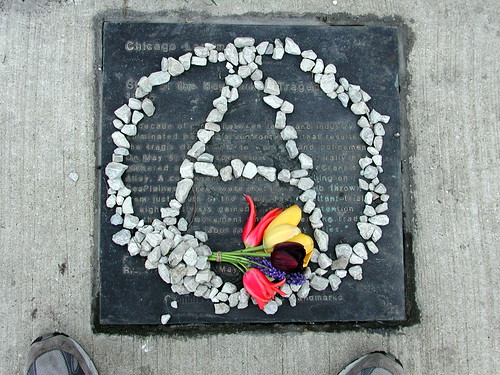Jason Kottke pointed out an intriguing analysis about the changing demographics of Chicago and similar cities, discovered in a periodical I usually avoid, The New Republic.

[Vulcan, a steel-worker working on a building being constructed in The Loop]
In the past three decades, Chicago has undergone changes that are routinely described as gentrification, but are in fact more complicated and more profound than the process that term suggests. A better description would be “demographic inversion.” Chicago is gradually coming to resemble a traditional European city–Vienna or Paris in the nineteenth century, or, for that matter, Paris today. The poor and the newcomers are living on the outskirts. The people who live near the center–some of them black or Hispanic but most of them white–are those who can afford to do so.
Developments like this rarely occur in one city at a time, and indeed demographic inversion is taking place, albeit more slowly than in Chicago, in metropolitan areas throughout the country. The national press has paid very little attention to it. While we have been focusing on Baghdad and Kabul, our own cities have been changing right in front of us.
[From Trading Places]
We can see that in our own neighborhood (So-Fu). In the eight years (and counting) I’ve lived in the West Loop, there have been at least 12 new high-rise condominium developments just within visual range, dozens more nearby, and even more in the South Loop. Literally tens of thousands of new family units have moved downtown, and there’s space for many, many more. Not to mention places like Logan’s Square (mentioned in the above referenced article), Pilsen, Wicker Park, Uptown, yadda yadda. The prices are not astronomical compared to Manhattan prices, but certainly not cheap.

[Construction Season Rag, West Loop]
If you feel that way, you might want to ride an elevated train going northwest, to the lesser-known Logan Square, a few miles beyond the Loop. Whatever Logan Square might be, it is not downtown chic. It is a moderately close-in nineteenth-century neighborhood with a history fairly typical for a city that A.J. Liebling once called “an endless succession of factory-town main streets.” Logan Square was developed primarily by Scandinavian manufacturers, who lived on the tree-lined boulevards while their workers, many of them Polish, rented the cottages on the side streets. By the 1970s, nearly all the Poles had decamped for suburbia, and they were replaced by an influx of Puerto Ricans. The area became a haven for gangs and gang violence, and most of the retail shopping that held the community together disappeared.
Logan Square is still not the safest neighborhood in Chicago. There are armed robberies and some killings on its western fringe, and, even on the quiet residential streets, mothers tell their children to be home before dark. But that hasn’t prevented Logan Square from changing dramatically again–not over the past generation, or the past decade, but in the past five years. The big stone houses built by the factory owners on Logan Boulevard are selling for nearly $1 million, despite the housing recession. The restaurant that sits on the square itself sells goat cheese quesadillas and fettuccine with octopus, and attracts long lines of customers who drive in from the suburbs on weekend evenings. To describe what has happened virtually overnight in Logan Square as gentrification is to miss the point. Chicago, like much of America, is rearranging itself, and the result is an entire metropolitan area that looks considerably different from what it looked like when this decade started.
Of course, demographic inversion cannot be a one-way street. If some people are coming inside, some people have to be going out. And so they are–in Chicago as in much of the rest of the country. During the past ten years, with relatively little fanfare and surprisingly little press attention, the great high-rise public housing projects that defined squalor in urban America for half a century have essentially disappeared. In Chicago, the infamous Robert Taylor Homes are gone, and the equally infamous Cabrini-Green is all but gone. This has meant the removal of tens of thousands of people, who have taken their Section 8 federal housing subsidies and moved to struggling African American neighborhoods elsewhere in the city. Some have moved to the city’s southern suburbs–small suburbs such as Dixmoor, Robbins, and Harvey, which have been among the poorest communities in metropolitan Chicago. At the same time, tens of thousands of immigrants are coming to Chicago every year, mostly from various parts of Latin America. Where are they settling? Not in University Village. Some in Logan Square, but fewer every year. They are living in suburban or exurban territory that, until a decade ago, was almost exclusively English-speaking, middle-class, and white.

[What More Can I Say – condo building, South Loop]
Footnotes:






















